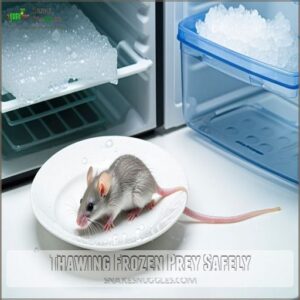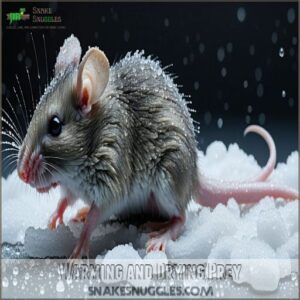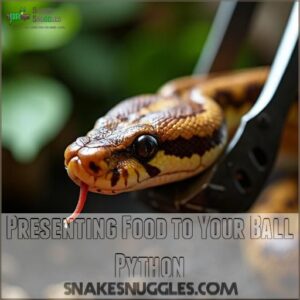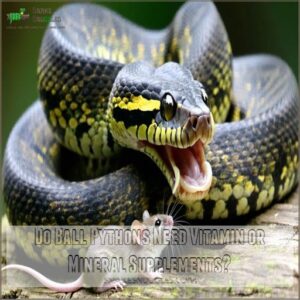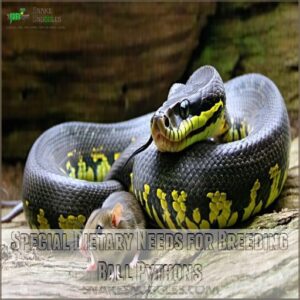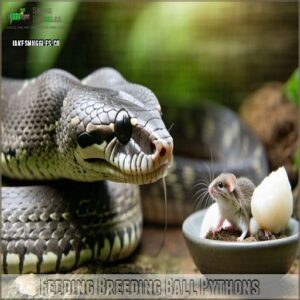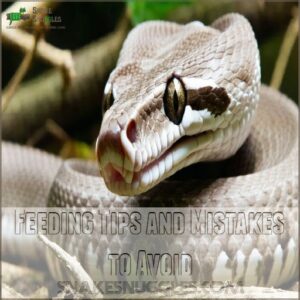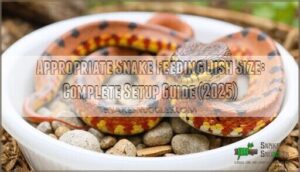This site is supported by our readers. We may earn a commission, at no cost to you, if you purchase through links.
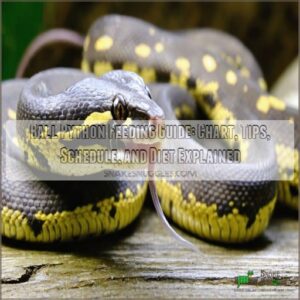 For ball python feeding, size and timing are key. Offer frozen-thawed rodents like mice or rats, with a size matching your snake’s midsection width (1-1.25 times its diameter).
For ball python feeding, size and timing are key. Offer frozen-thawed rodents like mice or rats, with a size matching your snake’s midsection width (1-1.25 times its diameter).
Feed juveniles every 5-7 days, while adults thrive on a meal every 2-3 weeks. Thaw prey safely using warm water, heat it to around 98-100°F, and use feeding tongs to avoid accidental bites.
Always monitor weight to prevent overfeeding—nobody wants an uncomfortably plump python! Keep feeding stress-free by maintaining a quiet, warm space, and skip meals during shedding.
Ready for some pro tips on managing picky eaters or fasting? Stay tuned!
Table Of Contents
- Key Takeaways
- Prey Selection for Ball Pythons
- Preparing Your Snake’s Food
- Feeding Frequency for Ball Pythons
- Presenting Food to Your Ball Python
- Nutritional Needs and Supplements
- Feeding Breeding Ball Pythons
- Feeding Tips and Mistakes to Avoid
- Ball Python Feeding Chart
- Frequently Asked Questions (FAQs)
- How often should I feed ball python?
- How do I know my ball python is hungry?
- Should I feed my ball python in its enclosure?
- How to feed a ball python for the first time?
- How do you feed a ball python?
- When should you feed ball pythons?
- Do ball pythons need feeding charts?
- Can ball pythons eat live food?
- How much should I feed my ball python?
- Should I feed my ball python during the day or night?
- Conclusion
Key Takeaways
- Feed your ball python frozen-thawed prey that is 1-1.25 times the width of its midsection, thawed and warmed to around 98-100°F for safety and digestion.
- Stick to a consistent feeding schedule: every 5-7 days for juveniles, 10-14 days for sub-adults, and 2-3 weeks for adults, adjusting based on age, weight, and appetite.
- Use feeding tongs to safely handle prey, reduce stress, and avoid your snake associating your hand with food.
- Monitor weight and growth to prevent overfeeding or underfeeding, and skip meals during shedding or periods of natural fasting.
Prey Selection for Ball Pythons
Choosing the right prey for your ball python is essential to keeping it healthy.
and ensuring proper growth.
You’ll need to match the prey species and size to your snake’s age, weight, and natural feeding habits.
Choosing The Right Prey Species
A ball python diet thrives on prey variety, with rats, mice, chicks, and quail making excellent options.
Younger snakes often accept mice first, which can be sourced from suppliers offering frozen mouse products.
Rat vs. mouse preferences vary; prey scent can help switch picky eaters between types.
Stick to frozen-thawed items for safety.
Avoid amphibians, eggs, or reptiles—these aren’t suitable.
A diverse ball python feeding guide guarantees proper nutrition.
Selecting The Correct Prey Size
Size matters when feeding ball pythons. Prey should match their midsection’s width, about 1–1.25 times its diameter. Too large can cause regurgitation; too small leaves them hungry.
Use a prey size chart to match age and weight ratios.
For example, young hatchlings need hopper mice, while adults thrive on small-to-medium rats. Proper sizing avoids growth issues and feeding mistakes.
Pre-killed or thawed frozen rodents, such as those from frozen rodent sources, are safer than live prey.
Prey Size Vs. Snake Size
Feeding your ball python the right prey size keeps it healthy and prevents issues like regurgitation. Prey should match the widest part of your snake’s body—no bigger, no smaller. Adult males weigh about 3 pounds, while females reach 3-5 pounds, so adjust accordingly.
For ideal feeding, it’s also key to factor in the ideal prey size, which is 1-1.25 times the snake’s mid-body diameter, as recommended by prey selection guidelines.
Use this guide for smart feeding:
- Stick to the widest body rule—it’s foolproof.
- Monitor the growth rate impact—adjust prey size periodically.
- Aim for 10-15% of body weight for young snakes.
- Follow a ball python feeding chart for weight specifics.
- Avoid overfeeding—health matters most!
Why Live Prey is Not Recommended
Live feeding might seem natural, but it’s a gamble with risks. Frozen-thawed mice are safer and far more convenient. Here’s why:
- Stress: Thrashing prey agitates your ball python.
- Injury risk: Teeth and claws can wound your snake.
- Parasite risk: Live prey may carry harmful hitchhikers.
- Handling difficulty: Escaping rodents create chaos.
Preparing Your Snake’s Food
Preparing your snake’s food properly keeps your ball python healthy and reduces stress during feeding.
You’ll need to safely thaw frozen prey, warm it to the right temperature, and handle it hygienically.
To safeguard your snake’s safety and wellbeing.
Thawing Frozen Prey Safely
Thawing frozen prey safely is key for ball pythons. Stick to refrigeration or cold water methods to avoid contamination and provide a healthy meal. Skip the microwave—uneven heating is risky! Use only dedicated tools for reptile feeding.
For more advice on safe thawing, check out water bath techniques like using a ziploc bag in warm water.
| Method | Thawing Time | Best Prey Types |
|---|---|---|
| Refrigeration | 5-12 hours | All prey sizes |
| Cold Water | 1-2 hours | Small to medium prey |
| Warm Water | 10-40 minutes | Small prey like mice |
| Room Air | 1-3 hours | Medium prey; monitor well |
Warming and Drying Prey
Once thawed, heating frozen prey properly keeps your ball python happy and healthy. Aim for a safe 98-100°F range to guarantee freshness and prevent bacterial growth.
- Place prey in a sealed bag and submerge it in warm water.
- Always skip the microwave—heat can get uneven.
- Use a temp gun to double-check warmth.
- Pat prey dry to avoid messing up enclosure humidity.
- Keep tools clean to maintain high standards of hygiene.
For more precise temperature control, consider using a snake food warmer.
Handling Prey Items Hygienically
You’ve warmed the prey perfectly—now it’s time to handle it like a pro.
Always wash your hands before and after to avoid spreading germs.
Use tongs for proper handling, keeping prey safe from contamination and your hands out of biting range.
Stick to clean surfaces and store frozen-thawed mice in airtight containers.
Practice safe thawing methods like refrigeration or cold water to limit bacterial growth.
Never leave thawed prey out for hours; discard uneaten items promptly for proper waste disposal.
These snake feeding tips keep ball python feeding stress-free and help you avoid common feeding mistakes for a healthy pet.
Feeding Frequency for Ball Pythons
Getting your ball python’s feeding schedule right helps their growth stay on track and helps avoid common health issues.
You’ll need to account for their age, size, and growth rate, as younger snakes eat more often than adults.
How Often to Feed Young Ball Pythons
Feeding a juvenile ball python every 5-7 days keeps their growth rate steady and helps them stay healthy.
Stick to the rule: prey size should match or slightly exceed the midsection width.
This consistent feeding schedule promotes proper development without overfeeding. Weight monitoring helps you adjust as needed following a reliable ball python feeding guide.
Feeding Frequency for Mature Ball Pythons
For adult ball pythons, stick to a feeding schedule every 14-21 days. Adjust based on their:
- Weight monitoring: Larger snakes need bigger meals, not more frequent ones.
- Fasting periods: Adults naturally fast, especially during the winter months.
- Feeding frequency: Maintain consistency to match their metabolism.
- Breeding impact: Breeding males and gravid females may need more food.
- Ball python feeding amount: Match prey size to about 5% of body weight.
Additionally, be mindful of ideal prey size, as it should be approximately 10% of snake’s weight.
Keep your python’s adult diet balanced!
Adjusting Feeding Frequency Based on Growth Rate
Ball python growth spurts mean updates to the feeding schedule.
Watch for weight changes—yearlings may need quicker feeding intervals or larger meals.
Tailor feeding frequency to each snake’s growth rate. Adjust the amount based on size and appetite since individual needs vary. Regular weight monitoring supports healthy development while preventing overfeeding.
Factors Affecting Feeding Frequency
Several factors shape your ball python’s feeding schedule:
- Age and Size: Younger, smaller snakes need frequent meals for growth; adults eat less often.
- Health and Shedding: Snake health and shedding cycles can lower feeding interest.
- Temperature and Breeding: Ambient temperature drop or breeding status may reduce ball python feeding frequency.
- Proper Feeding Charts Snake Feeding Charts can also be referenced to help determine the right feeding schedule for your pet.
Presenting Food to Your Ball Python
When feeding your ball python, it’s important to use tools like feeding tongs to keep your hands safe and prevent your snake from mistaking them for prey.
Make sure the food is properly warmed, and give your snake plenty of time and privacy to eat in a calm, stress-free environment.
Using Feeding Tools Safely
Feeding tools like tongs or hemostats are your go-to for safe handling during meals. They help you manage frozen, prekilled, or even live prey while ensuring bite prevention.
Always sterilize tools before and after use to avoid spreading bacteria.
Opt for long feeding tongs for better control and distance. Discard uneaten prey properly.
These simple practices safeguard both you and your snake, keeping feeding sessions organized and stress-free. Safe handling is key. Sterilize tools to prevent bacterial spread.
Allowing The Snake Privacy While Eating
Set up a quiet feeding space to reduce stress during the ball python feeding process. Avoid using a separate container to feed your snake, as it can cause unnecessary anxiety.
Hiding spots in the feeding enclosure help the snake feel secure.
Post-feeding, observe from a distance to avoid disturbing digestion and allow for proper snake digestion time.
Privacy guarantees a calm, successful feeding experience.
Maintaining Optimal Temperature for Feeding
Keeping the right thermal gradient is essential for your ball python’s feeding and digestion. Aim for ideal enclosure temps: the warm side should be 86-90°F, and the cool side 72-80°F. Use a heat mat with a thermostat for control. Lower temps can discourage eating and slow digestion.
- Always monitor temperatures with a reliable thermometer.
- Avoid dips below 80°F to keep your snake comfortable and feeding-ready.
- Adjust for seasonal changes to maintain consistency, especially during ball python frozen feeding or digesting larger meals.
Avoiding Overfeeding and Obesity
Avoid overfeeding your ball python by sticking to consistent feeding schedules and learning body condition scoring.
Signs of obesity include fat rolls and a loss of the triangular body shape.
Prevent common feeding mistakes with these simple tips:
- Monitor healthy weight ranges through regular weighing.
- Offer proper feeding amounts based on size and age.
- Encourage exploration with climbing obstacles.
- Avoid overfeeding habits by spacing meals appropriately.
- Stick to your ball python feeding guide.
Nutritional Needs and Supplements
You’ll want to make sure your ball python’s diet meets all its nutritional needs, even if supplements aren’t always necessary.
Calcium, vitamin D3, and UVB lighting play an important role, especially for breeding snakes or those without natural sunlight.
Do Ball Pythons Need Vitamin or Mineral Supplements?
Ball pythons typically don’t need supplements if their diet includes whole prey, which covers most nutritional requirements.
Still, occasional ball python calcium supplements or multivitamins can help, especially for breeding pythons. If UVB lighting isn’t used, vitamin D-enriched calcium boosts nutrition.
Meeting ball python nutritional requirements through dietary variety and proper prey selection supports a balanced diet without relying heavily on python vitamin supplements.
It’s also necessary to provide a balanced diet through proper ball python feeding practices, such as using frozen mice.
Dusting Food With Calcium or Multivitamin Powder
Dusting prey with ball python calcium supplements, like Repashy Calcium Plus LoD or Arcadia RevitaliseD3, helps promote strong bones and prevents deficiencies, such as Metabolic Bone Disease.
Opt for once-a-week dusting—this method balances python nutrition.
Lightly coat thawed prey for even coverage.
Supplement frequency matters, and healthy prey selection impacts overall nutrition.
Simple tweaks lead to a thriving snake!
Importance of UVB Lighting for Calcium Metabolism
Pairing UVB lighting with calcium supplementation isn’t just smart—it’s imperative. UVB promotes Vitamin D3 synthesis, allowing better calcium absorption and preventing Metabolic Bone Disease (MBD).
Use a quality UVB lamp to mimic sunlight and boost your snake’s health. Place it at the perfect distance for safe exposure.
- Benefits include:
- Stronger bones
- Enhanced calcium absorption
- Prevention of MBD
- Fewer health issues
- Improved activity
- Better overall wellbeing
Special Dietary Needs for Breeding Ball Pythons
Breeding ball pythons have unique nutritional needs to support reproduction.
Females require larger, nutrient-rich meals to build fat reserves for egg production and growth. Males need consistent, balanced feeding to maintain energy and vigor during frequent mating sessions.
Feeding schedules should adapt to breeding frequency, with females receiving weekly meals and males every 10–14 days. Offer prey 1 to 1.25 times the snake’s mid-body size to meet their caloric needs.
Here’s a helpful table:
| Nutritional Factor | Females | Males |
|---|---|---|
| Meal Size | Larger prey | Regular-sized prey |
| Frequency | Weekly | 10–14 days |
| Key Focus | Fat reserve building | Consistent energy levels |
Healthy python nutrition supports breeding success!
Feeding Breeding Ball Pythons
When breeding ball pythons, you’ll need to adjust their feeding routine to meet the demands of reproduction.
Females require larger meals to build fat reserves for egg-laying.
Males may need more frequent feeding during the breeding season.
Increased Feeding Frequency for Breeding Males
During mating season, adjust your male ball python’s feeding schedule to meet energy demands for breeding.
Keep meals small but frequent to maintain energy without overfeeding. Monitor weight and health as part of breeding frequency impact.
- Feed every 7-10 days during mating season.
- Provide prey matching their midsection’s thickness.
- Resume normal feeding habits post-mating to restore weight.
Increased Food Intake for Breeding Females
Meeting the nutritional needs of gravid females is essential for egg production.
Increase ball python feeding amounts with larger, frequent meals while monitoring their weight gain goals to verify they’re healthy, not overfed.
Keep tracking ball python feeding habits for balance.
Post-laying care demands recovery feeding adjustments, but right now, focus on optimizing the pregnant diet.
Building Fat Reserves for Egg-Laying
To help your ball python build fat reserves for egg-laying, focus on proper nutrition and methods that align with their feeding schedule.
Here’s how to meet those fat reserve goals:
- Offer slightly larger meals, like small or medium rats, which are ideal prey types for increasing calorie intake.
- Adjust the feeding schedule to include meals every 7-10 days, supporting consistent weight gains based on your ball python feeding chart.
- Monitor progress through regular weigh-ins. Aim to track gradual weight increases without overfeeding.
Weight monitoring supports successful breeding, while a steady diet supports a gravid female’s stamina during egg-laying. Keep fresh water available.
Monitoring The Snake’s Condition During Breeding
Keep an eye on your ball python’s weight gain and body condition during breeding, as females typically reach sexual maturity at approximately 1500g (2-2.5 years old) Ball Python Maturity.
Females may stop eating as egg production starts, so track appetite changes closely.
Look for any swelling in the mid-body area, a sign of developing follicles.
Males often show increased activity when courting.
Monitoring size and health promotes successful ball python breeding and overall well-being.
Feeding Tips and Mistakes to Avoid
Feeding your ball python isn’t complicated, but making a few common mistakes can lead to stress or health issues.
By understanding what to avoid, like overfeeding or handling too soon after a meal, you’ll keep your snake healthy and eating consistently.
Avoiding Overfeeding and Underfeeding
Feeding your ball python isn’t just about tossing in prey—body condition scoring is key.
An overweight snake struggles with poor health, while an underfed one sees slowed growth rates.
Use weight monitoring and feeding cues like nighttime activity to adjust meal frequency. Stick to prey roughly matching the snake’s girth.
Skipping a week won’t harm a python—healthy ones can go months without eating.
Consult a detailed ball python feeding guide chart to avoid common feeding mistakes affecting long-term health.
Not Handling The Snake After Feeding
Skipping handling after feeding isn’t just good advice—it’s a must. Ball pythons need 48-72 hours for digestion, and interference raises regurgitation risks. Stress reduction is key for their health post-feeding.
- Plan handling for non-feeding days.
- Give them quiet time in the enclosure.
- Avoid sudden movements near the tank.
- Use feeding tools for hygiene.
- Watch for post-feeding behavior shifts.
Not Feeding a Shedding Snake
When your ball python enters its shedding cycle, characterized by milky eyes and dull skin, it’s smart to pause feeding.
Eating during this time can cause stress, digestion issues, or even food refusal.
Adjust the ball python feeding schedule to prioritize skin health. Once shedding completes, safely resume feeding to support recovery and normal routines.
Not Forcing The Snake to Eat
It’s normal for a ball python to refuse food occasionally. Don’t panic or force it to eat; patience is key.
Look for hunger cues like nighttime activity, but check for refusal reasons like shedding, stress, or illness. Health checks confirm there’s no underlying issue.
Persistent refusals may be due to snake anorexia causes.
Persistent refusals? Consult a vet. Avoid ball python feeding mistakes and focus on understanding your snake’s needs.
Ball Python Feeding Chart
A feeding chart helps you match your ball python’s age, weight, and size to the right prey and feeding schedule.
It’s a simple way to help your snake stay healthy while avoiding overfeeding or malnutrition.
Feeding Chart for Different Age Groups
Understanding growth stages helps tailor the ball python feeding chart.
A ball python’s diet and feeding habits have a substantial impact on its size and growth rate, as discussed in the Ball Python Size and growth chart guidelines.
Hatchlings eat every 5-7 days, juveniles weekly, and adults every 10-21 days, adjusting for prey size and feeding needs.
Here’s a quick feeding guide for ball pythons:
| Growth Stage | Feeding Frequency | Example Prey |
|---|---|---|
| Hatchling | Every 5-7 days | Pinky mouse/rat |
| Juvenile | Every 7 days | Fuzzy rat/small mouse |
| Sub-adult | Every 7-10 days | Adult mouse/rat pup |
| Adult | Every 10-21 days | Small/medium rat |
| Mature (3+ yr) | Every 14-28 days | Medium rat |
Feeding Chart for Different Weight Groups
Weight-based feeding simplifies care.
For a 700-gram ball python, offer prey every 7-14 days, sized at 10-15% of its body weight.
Balance feeding frequency with your python’s growth.
Use this quick chart:
| Weight (grams) | Prey Size (grams) | Meal Frequency | Notes |
|---|---|---|---|
| 100-300 | 10-25 | Every 5-7 days | Juveniles grow fast |
| 300-700 | 25-80 | Every 7-14 days | Monitor body shape |
| 700-1500 | 80-150 | Every 14-21 days | Avoid overfeeding |
| 1500+ | 150+ | Every 21-50 days | Adults need less |
Adjust based on growth and appetite!
Adjusting The Feeding Chart Based on Growth Rate
Sometimes, growth spurts call for changes. Keep weight monitoring consistent—if your snake’s growing faster than the ball python feeding chart predicts, tweak the meal size and feeding frequency. Snakes develop differently, so adapt to individual needs using the ball python feeding schedule.
For the best growth, make sure you’re aware of the factors affecting ball python growth, such as genetics and diet.
| Growth Rate | Feeding Frequency | Prey Size | Snake Weight | Adjustments Recommended |
|---|---|---|---|---|
| Slow | Every 14 days | Medium Rat | 500-900g | Increase meal frequency |
| Average | Every 10-14 days | Small Rat | 900-1500g | Maintain regular schedule |
| Average | Every 7-10 days | Rat Pup | 300-500g | Match snake’s growth rate |
| Fast (spurt) | Weekly | Small Rat | 1500-1800g | Offer larger prey sizes |
| Mature Adult | 2-3 weeks | Medium Rat | 1800+g | Adjust as weight stabilizes |
Frequently Asked Questions (FAQs)
How often should I feed ball python?
Feed hatchlings every 5-7 days, juveniles every 7-14 days, and adults every 2-5 weeks. Offer prey 1-25 times the snake’s midsection diameter. Adjust based on age, size, and growth rate.
How do I know my ball python is hungry?
Your ball python’s hunger will slither into view when it becomes more active, especially at night.
It might also track movement or position itself near its enclosure opening.
It starts flicking its tongue frequently.
Should I feed my ball python in its enclosure?
Feeding in the enclosure is fine if it keeps your ball python calm.
Use tongs to avoid hand association, and remove uneaten prey after 12 hours.
Avoid handling the snake for 48 hours after feeding.
How to feed a ball python for the first time?
Start by offering a frozen-thawed small mouse matching your snake’s midsection width.
Use feeding tongs to present the warmed prey near its head.
Avoid handling before or after to reduce stress and aid digestion.
How do you feed a ball python?
Think of it like offering a warm dinner.
Use tongs to present thawed prey warmed to 100°F, matching prey size to your python’s girth.
Feed inside its enclosure, then let it digest undisturbed for 48 hours.
When should you feed ball pythons?
Feed hatchlings every 5-7 days, juveniles weekly, and adults every 2-3 weeks.
Match prey size to the snake’s midsection diameter.
Adjust based on age, weight, and activity. Fast during shed cycles or prolonged anorexia.
Do ball pythons need feeding charts?
A feeding chart is like a road map for your ball python’s health.
It helps track prey size, feeding frequency, and growth, ensuring your snake’s diet stays balanced and suits its age and weight.
Can ball pythons eat live food?
Yes, ball pythons can eat live food, but it’s riskier.
Live prey may injure the snake.
Frozen-thawed rodents are safer and just as nutritious.
If using live food, supervise closely to prevent accidents.
How much should I feed my ball python?
Offer prey about the width of your ball python’s midsection.
Young snakes eat every 5-7 days, sub-adults every 10-14 days, and adults every 2-3 weeks.
Adjust portions based on weight and growth.
Should I feed my ball python during the day or night?
Your ball python naturally hunts at night.
So feeding in the evening or after dark aligns with its instincts.
It’s like scheduling dinner when they’re most alert and ready for a meal.
Conclusion
Think of your ball python’s feeding routine as the rhythm of a well-tuned clock—each meal timed and sized to keep it healthy and content.
By offering appropriately sized, frozen-thawed prey, sticking to recommended feeding intervals, and following safe preparation practices, you’re setting your snake up for long-term health.
Pay attention to growth, behavior, and weight to fine-tune the process. With these ball python feeding tips, you’ll keep your snake thriving, one careful meal at a time.


